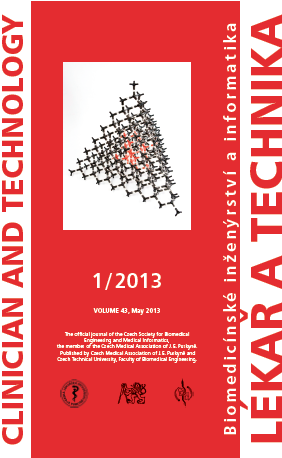SROVNÁNÍ RŮZNÝCH PŘÍSTUPŮ HRANOVÉ DETEKCE KONČETINOVÝCH TEPEN V PODÉLNÉM ŘEZU ULTRAZVUKOVÉHO OBRAZU
Keywords:
ultrazvuk, končetinové tepny, hranová detekce, hranové operátoryAbstract
Automatická detekce tepen v ultrazvukovém obraze může být velmi užitečným nástrojem při hodnocení funkčního stavu a diagnostice mnoha onemocnění vaskulárního systému. Hranová reprezentace obrazu může poskytovat významnou informaci o lumenu tepny a stavbě tepenné stěny nebo o průběhu a větvení tepen. U dynamických studií lze metody hranové detekce s výhodou využít také k hodnocení mechanických a elastických vlastností tepen. Hranovou detekci tepen v podélném řezu ultrazvukového obrazu jsme provedli pomocí různých běžně používaných hranových operátorů a detektorů založených na první derivaci (Roberts, Sobel, Prewitt, Kirsch, Robinson) nebo druhé derivaci (Laplace, LoG) obrazové funkce. Pro srovnání jsme zvolili také výsledky detekce hran v obraze metodou prostého prahování. Pro lepší výsledky hranové detekce jsme na vstupní obraz aplikovali některé základní metody předzpracování obrazu (doostření, vyhlazení, úprava jasu, úprava spektra) a prostředky matematické morfologie (eroze, dilatace, uzavření, otevření). Těmito postupy jsme se snažili maximálně eliminovat šum a rušivé struktury v obraze, které způsobovaly chybnou detekci hran a negativně ovlivňovaly výsledek. Všechny aplikované postupy poskytly uspokojivé výsledky detekce. Volba nejoptimálnějšího způsobu hranové detekce závisí na konkrétní situaci a je podmíněna jednak vhodně zvolenými parametry v jednotlivých krocích detekčního algoritmu, jednak také typem, kvalitou a akvizičními parametry konkrétního vstupního ultrazvukového obrazu.Downloads
Published
Issue
Section
License
Copyright (c) 2017 Martin Sedlář, Vojtěch Mornstein

This work is licensed under a Creative Commons Attribution 4.0 International License.
Authors who publish with this journal agree to the following terms:
- Authors retain copyright and grant the journal right of the first publication with the work simultaneously licensed under a Creative Commons Attribution License (https://creativecommons.org/licenses/by/4.0/) that allows others to share the work with an acknowledgment of the work's authorship and initial publication in CTJ.
- Authors are able to enter into separate, additional contractual arrangements for the non-exclusive distribution of the journal’s published version of the work (e.g., post it to an institutional repository or publish it in a book), with an acknowledgment of its initial publication in this journal.
- Authors are permitted and encouraged to post their work online (e.g., in institutional repositories or on their website or ResearchGate) prior to and during the submission process, as it can lead to productive exchanges.
CTJ requires that all of the content of the manuscript has been created by its respective authors or that permission to use a copyrighted material has been obtained by the authors before submitting the manuscript to CTJ. CTJ requires that authors have not used any copyrighted material illegally, as for example a picture from another journal or book, a photo, etc. It is the author’s responsibility to use only materials not violating the copyright law. When in doubt, CTJ may ask the authors to supply the pertinent permission or agreement about the use of a copyrighted material.
The opinions expressed in CTJ articles are those of authors and do not necessarily reflect the views of the publishers or the Czech Society for Biomedical Engineering and Medical Informatics.


